The whole application is developed in Webkit (UIWebView / Safari Mobile). A native Cocoa wrapper delegates location, compass and accelerometer to Javascript in the UIWebView. The 3D scene is based on Safari Mobiles brilliant 3D CSS transforms. The Ajax part is done with jQuery. After writing some native iPhone apps this Webkit approach seems to be ideal for rapid development of applications independent of the iPhone UI.
maandag 27 juli 2009
If you like your iPhone and love to Twitter look at this
woensdag 22 juli 2009
Sonic Clears Path for 3D Movie Downloads...start saving money for your home cinema upgrade
Novato, California (July 21, 2009) — Sonic Solutions® (NASDAQ: SNIC) is leveraging its broad range of Hollywood to Home™ digital media applications, technologies and services, including its Roxio CinemaNow® movie delivery service, to provide consumers a convenient way to access and enjoy 3D movies at home. Sonic's solution for the digital delivery of 3D entertainment includes professional tools for preparing content for electronic distribution and sell-through, services for delivery of device-optimized 3D content, and software for PC playback.
"The same consumers demanding the finest in home video quality and convenience are now expecting to soon enjoy the score of new 3D theatrical releases in the comfort of their homes," said Richard Doherty, Research Director for The Envisioneering Group. "All the studio heads, cinematographers and technical wizards that we enjoy a dialogue with are confident that 3D in the home will soon become the next entertainment breakthrough. Sonic's long experience in providing tools that empower Hollywood to deliver movies into homes on disc and savvy in streaming content to CE platforms through CinemaNow will surely help propel 3D out of the theatre screen and literally into living rooms around the world."
Sonic is teaming with a number of industry leaders to ensure the 3D content delivered can be enjoyed across a range of 3D-capable devices. To provide a stunning visual experience for PC users, Sonic has teamed with NVIDIA. 3D movies from Roxio CinemaNow will be optimized for NVIDIA® GeForce® graphics processing units (GPUs) and the Roxio CinemaNow player will support NVIDIA 3D Vision® and 3D Vision-Ready displays, including the Samsung SyncMaster 2233RZ and ViewSonic® FuHzion® VX2265wm currently in the market for 3D gaming.
"NVIDIA has pushed technological and design boundaries to deliver an unrivaled 3D gaming experience," said Ujesh Desai, vice president of GeForce business at NVIDIA. "Now, through our collaboration with Sonic and integrated support for Roxio CinemaNow content across our entire line of 3D Vision-capable GPUs, including the GeForce GTX 295, 285, and 275 processors, we hope to introduce millions of customers to the immersive world of 1080p 3D premium movies at home."
3D movies from CinemaNow will be delivered via the PC, which will perform the necessary decoding to display them on both 3D-ready PC displays and 3D-ready digital TVs and projectors. Unlike older anaglyph (colored glasses) solutions, this solution provides a true and compelling 3D experience, much like that created by today's digital-theater systems. Sonic is also collaborating with consumer electronics manufacturers in order to deliver 3D content directly to next-generation connected HDTVs and Blu-ray Disc players.
"Technical advancements by industry leaders such as Mitsubishi Electric, NVIDIA and Samsung have created the necessary display and processing platforms to bring the 3D cinematic experience home," said Dave Habiger, president and CEO, Sonic Solutions. "Now through Roxio CinemaNow we will enable consumers to conveniently access 3D entertainment instantly and enjoy its depth and impact on the small screen from the comfort of their couch."
Sonic has relationships with more than 250 content providers and a content portfolio that includes entertainment from all major Hollywood studios and independent distributors. Roxio CinemaNow offers a massive selection of premium video entertainment for rental or purchase, including new releases from major Hollywood studios often on the same day the DVD is available in stores. CinemaNow's cloud-based media services power devices from multiple manufacturers, forming a connected ecosystem that consumers can use to seamlessly choose, move and view video entertainment.
The CinemaNow ecosystem currently includes PCs, connected TVs, set top DVRs, Blu-ray Disc and mobile media players from leading manufacturers such as Archos, Dell, HP, LG, Microsoft, Nintendo, Pioneer, Samsung and TiVo. As well as being available on a range of consumer electronics, Roxio CinemaNow is currently powering internet movie stores for Lionsgate, Warner Bros. and Blockbuster, and is instantly accessible through Bestbuy.com.
About Sonic Solutions
Sonic Solutions® (NASDAQ: SNIC) is powering the digital media ecosystem through its complete range of Hollywood to Home™ applications, services, and technologies. Sonic's Roxio® products enable consumers to easily manage and enjoy personal digital media content as well as premium Hollywood entertainment on a broad range of connected devices. A wide array of leading technology firms, professionals, and developers rely on Sonic to bring innovative digital media functionality to next-generation devices and platforms. Sonic Solutions is headquartered in Marin County, California.
Forward Looking Statements
This release may contain forward looking statements that are based upon current expectations, including the launch, distribution, and market acceptance of the Roxio CinemaNow service. Actual results could differ materially from those projected in the forward looking statements as a result of various risks and uncertainties, including those discussed in Sonic Solutions' annual and quarterly reports on file with the Securities and Exchange Commission. This press release should be read in conjunction with Sonic Solutions' most recent annual report on Form 10-K, Form 10-Q and other reports on file with the Securities and Exchange Commission, which contain a more detailed discussion of the Company's business including risks and uncertainties that may affect future results. Sonic Solutions does not undertake to update any forward looking statements.
Sonic, the Sonic logo, Sonic Solutions, Roxio, CinemaNow, and Hollywood to Home, are trademarks or registered trademarks owned by Sonic Solutions in the United States and/or other countries. All other company or product names are trademarks of their respective owners and, in some cases, are used by Sonic Solutions under license. Specifications, pricing and delivery schedules are subject to change without notice.
dinsdag 14 juli 2009
There's more than just augmented reality
Welcome to 7scenes, we're a brand new GPS platform for games and tours! We're here for all organisations that want to deliver new mobile experiences to their audiences.
Interested in a new way of publishing content to mobile phones? You've come to the right place!
Consider the city an extension of your organisation, a fascinating place for you to publish and reach people in a different way. The city with all its (hidden) information is a beautiful stage filled with historic events, personal stories, cultural meaning, demographics, social relationships and much, much more. Something has occurred on every street corner and every brick can claim its own history.
Combining these surroundings, your content and phones that have made internet mobile and location aware (GPS), we can now interact with places in a whole new way! We are all about making these new experiences possible and offer a mobile and online platform that makes it easy to create, play and share GPS-based games and tours.
Imagine cultural city tours that allow museums and archives to reach beyond their exhibition walls, imagine an interactive festival tour playfully collecting your public's feedback, imagine an exclusive game that creates a new brand experience, imagine... Imagine your scenario, how would you like the city to be experienced?
These scenarios are created by linking locations to content - photos, videos, sounds and notes -, adding challenges and choosing from a range of (game) rules, together shaping what we call a scene. A location-based experience that lets people see their surroundings from a new point-of-view using their mobile phone.
35 Awesome Augmented Reality Examples
| If it wasn't for Twitter and social media as a whole grabbing all the headlines Augmented Reality would be the most talked about "technology" of 2008/2009. While the roots of the technology have been around since as early as the 1990's (remember VR games!) it's only in the last 12 months has the interactive industry taken to it like moths to a flame. Below you will find some of the worlds biggest brands dipping their toe into "Augmented Reality". Some are in it for the PR aspect others trying to find a useful application. Many just to satisfy their need to do something new. The technology has it's limitations though. Not only do you need a web cam but also a printer to activate it. Add to that one requires a download and installation of an application you cut your potential audience down considerably. That said I enjoy watching the videos and demos as much as interacting with it myself. If you know of any interesting applications for AR please comment below. I know there is much more out there and my limited research was focused on the advertising and marketing side rather than the tech and art side. Augmented Reality!? That's so 2008 Has AR jumped the shark? Well if Virtual Magicians are using it I think that's your answer. For me the best application of this is in store and also with kids toys. Both applications have far more useful applications than a fun web toy. Below are 35 great examples of where Augmented Reality and their applications to the commercial and art world. Correction Update: Apologies to Metaio who I incorrectly forgot to credit as the technology behind the Mini and Lego examples. This is why you don't post at 1am :) |
| Rubberduckzilla I had not seen any arcade style games in AR before this. Fun and stupid and it was meant to be. Agency: Poke London [UK] View | More Info |
| GE Smart Grid For such a dry subject this execution generated a lot of buzz. Agency: Goodby, Silverstein & Partners [US] View |
| |
| Assassins Creed 2 Teaser Gamers love hidden codes and content and this was the first video game site to use AR. Agency: Unknown View |
| |
| Earth Hour World in Your Hands So the way to save the world is to print out useless paper? Agency: Wunderman [AU] View |
| Relapse 3D Art Comp Turning the logo into an art canvas was nice idea. Too bad the entries in the comp are so shite. Agency: Outside Line [UK] View |
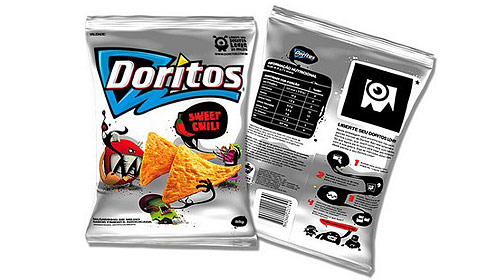 |
| Doritos Sweet Chili Wow packaging with AR is already here. Doritos moved fast. Agency: View |
| Living Sasquatch It's a video editor with a 3D Sasquatch. Quite impressive and the video record feature is great. Agency: Boffswana [AU] View |
| |
| Mini Germany Demo This was the first big brand example I saw last year. Couldn't get it to work on my laptop :( Agency: Unknown Technology: Metaio View | Case Study |
| |
| Papas Road Trip Virtual Ride Another brand with their packaging altered to have AR codes. Agency: Unknown View |
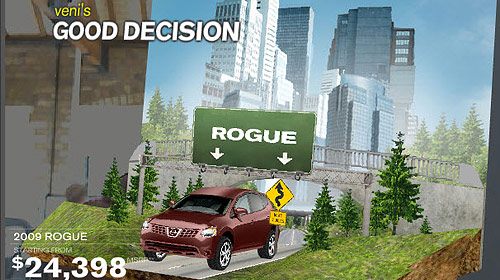 |
| Nissan Good Decision The decision maker and then AR surprise at the end is nice. Agency: Unknown View |
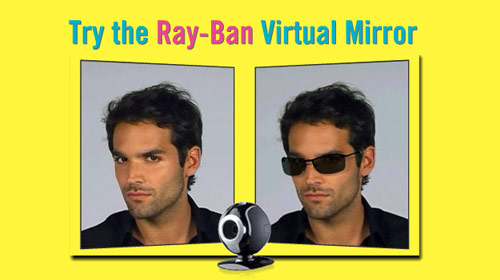 |
| Ray-Ban Virtual Mirror Probably the most practical application I've seen online. Too bad another download is needed Agency: Unknown Technology: Fitting Box [FR] View |
| Topps Virtual Playing Cards I wish this was around when I collected playing cards. The possibilities are endless. Technology: Total Immersion View |
| |
| Night at the Museum 2 Comes to Life Half promotion for the film half promotion for the news paper. Agency: Soap [AU] Technology: Total Immersion View |
| USPS Priority Mail Box Simulator A semi useful application of Augmented Reality. Agency: AKQA [US] View |
| Family Football Virtual Trophy Agency: TBWA | Special Moves [UK] View Note: Currently not on site |
| |
| Experience the Enterprise Paramount went all out on this execution for Star Trek. Agency: Unknown Technology: Total Immersion View |
| |
| Join Star Fleet Academy Another Star Trek augmented reality promo. Agency: Unknown View |
| McDonalds Dippers Game Agency: Unknown View |
| ADIDAS Virtual Avatar Agency: Unknown Technology: Total Immersion |
| Lego Store at Disney Land This must blow kid's minds and parent's wallets. Technology: Metaio View | PR |
| Eye of Judgment for PS3 Consoles are also getting in on the action. View |
| Nissan Cube Agency: Unknown View |
| Fanta Games Fanta pushing the mobile aspect of the technology. Agency: Ogilvy View | More Info |
| BMW Z4 in 3D I love the real life montage of the car. Takes this to a new level of fun. Agency: Dare [UK] View | More Info |
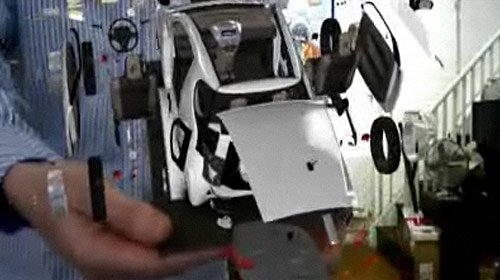 |
| Toyota IQ Reality Agency: Unknown View |
| BMW Factory R&D By: BMW |
| Not just brands. Artists, tech heads and musicians are getting into Augmented Reality as well. Here's some non branded examples. |
| Virtual Drumkit Looking for this to be re-skinned for a brand soon By: Squidder View |
| Augmented Reality T-Shirts + Twitter Status= "I'm wearing a Twitter shirt!" By: Squidder View |
| Augmented Reality Mobile Game: Catapult I want this now! By: Unknown View |
| Level heads This looks like a lot of fun Agency: Julian Oliver View |
| Augmented Reality Card Trick By: Virtual Magician |
| |
| Julian Perretta's 3d video for "Ride My Star" music video Agency: Unknown View |
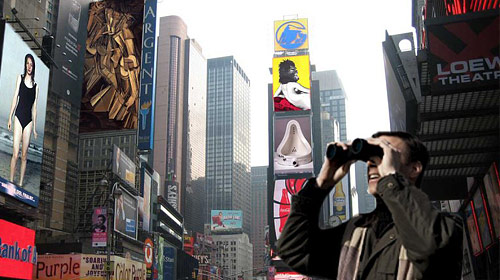 |
| The Artvertiser I love how anti-advertising the art world is. View |
| Arhrrrrrr Zombie Game (look for the Skittles integration!) I missed this at GDC. Looks fantastic. By: GVU Center's Augmented Environments Lab at Georgia Tech, in collaboration with SCAD-Atlanta View |
| Augmented Reality Snow Flakes Agencies jumped in for the 2008 Xmas card rush Agency: Tellart View |
| Special Moves Xmas Agency: Special Movies [UK] View Thanks Iain for the video |
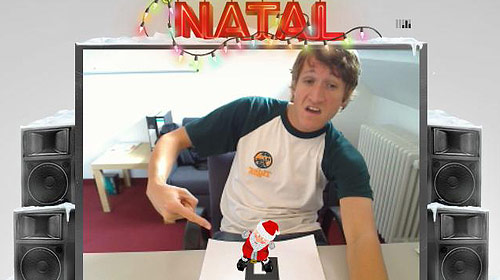 |
| McCaan Funky Natal Agency: McCaan [BR] View | More Info |
| Scope Augmented Reality Toys There isnt a toy executive alive that woulnd't get excited by this. By: Frantz Lasorne More Info |
Technologies - Total Immersion:This French company has been the leader in the Augmented Reality field for commercial use. If you are after the best qality 3D this is the one to go with. - Metaio: This German based company is big competitor to Total Immersion and has been behind some of the latest campaigns for Mini and Lego. |
| I can't mention augmented reality without showing this video. |
| If you enjoyed this feature you might also like our advertising features on Media Buys Creatives Will Love, Sexiest Banner Ads, Crowded Ads, Agency Xmas Cards 2008, 2007 & 2006 the 2008 US Election |
zaterdag 11 juli 2009
the Augmented Reality Hype Cycle
This year Augmented Reality (AR) is out of the box. It has escaped from the universities and is spreading like wild fire. It’s being written about more and more, especially by marketing people, who go for hypes first. This last month I’ve personally heard about at least 4 advertising agencies working on it. On Twitter its mentioned at least 5 times an hour. What types of Augmented Reality are there and where do we stand?
To frame this and differentiate the levels of AR I made the Augmented Reality Hype Cycle. It is inspired by Robert Rice’s article “Is it too early for Augmented Reality?” and expands on the AR Levels which he describes in “Augmented Vision and the Decade of Ubiquity “. The Gartner Hype Cycle is a great method to plot new technologies and applications.
In the Hype Cycle I focus on technology that is already out there and which application is aimed at the individual. Not Industrial. Also I focus on mobile when ever possible.

There are 4 Levels of AR (the larger grey titles):
- Level 0 - Physical World Hyper Linking
- Level 1 - Marker Based AR
- Level 2 - Markerless AR
- Level 3 - Augmented Vision
LEVEL 0 - Physical World Hyper Linking
 This is the oldest form and an addition to Rices’s 3 initial Levels of AR. It is a way to link the physical world to the virtual world. It starts with the 1D (UPC) bar code that’s on every product you have. It’s the identifier as registered in the database. The same can be said for 2D codes of which QR-codes are best known. Last part of this group is 2D image recognition. Most used mobile application is the recognition of a company logo or film poster which will then redirect you to a site for more information.
This is the oldest form and an addition to Rices’s 3 initial Levels of AR. It is a way to link the physical world to the virtual world. It starts with the 1D (UPC) bar code that’s on every product you have. It’s the identifier as registered in the database. The same can be said for 2D codes of which QR-codes are best known. Last part of this group is 2D image recognition. Most used mobile application is the recognition of a company logo or film poster which will then redirect you to a site for more information.
Being the oldest, this form of AR is the most developed. Its also the simplest and doesn’t involve real time rendering and display of graphics. Some may not even call it AR. General adoption of this technology will happen within a year. Most Nokia phones are already outfitted with the software for 1D and 2D bar code scanning. 2D scanning is stuck on the slope of enlightenment and will be surpassed by 2D image recognition in the coming year.
Examples of 1D & 2D Barcodes:
- Compare everywhere
- Snapptell (also image recognition)
- ShopSavvy
- Al in one review video of these three applications
- Densowave
- Kaywa
- Shotcode
Examples 2D Image Recognition
LEVEL 1 - Marker Based AR
 This is where the hype is now. Augmented reality based on markers. Its the first step for real AR because it enables real time processing of ‘reality’ through the recognition of markers and subsequently real time rendering and display of graphics on top of this reality.
This is where the hype is now. Augmented reality based on markers. Its the first step for real AR because it enables real time processing of ‘reality’ through the recognition of markers and subsequently real time rendering and display of graphics on top of this reality.
The first type is the 2D Marker AR which is PC and web cam based. Almost all applications work use an Internet connection to retrieve more information. The marker is the black and white square image you print out and hold in front of your web cam to see a 3D animation.
This is what most people are doing. There are also free toolkits to develop applications and now also Flash based which explains a lot of the popularity.
Next step up is 2D Marker AR with a mobile device. This is tricky-er because it involves a lot or real time processing and a very capable phone. For instance it is not possible on the iPhone because the OS does not allow for real time video processing. You also can’t record video with it as yet. It is possible with a hacked iPhone though.
2D Marker AR is most seen on Windows Mobile devices surprisingly enough. Coolest is 3D recognition, where the mobile recognizes a chair or another physical object and goes on to augmented it.
Level 1 - Marker Based AR is moving from the technology trigger to just before the actual peak of inflated expectations. For now it will not go away and in the coming year PC and Mobile 2D marker based AR will be the IN thing. Where the mobile version will be lagging in comparison to the PC based version due to the lack of computing power and other mobile issues. When the novelty is worn off the actual application value will prove to be thin. Its no real money maker except for marketing and PR applications. On the mobile it will last a bit longer when good games come out. The most promising, 3D recognition, is in the tail of Level 1 - Marker Based AR and is hardly a reality yet.
Examples of 2D Marker AR - PC & Web cam based:
- ARtoolkit
- ARtag
- EasyON
- Total Immersion, video of trading card application
- Metaio, Vuzix demo GDC 2009
- Beyond Reality - Augmented Reality Games, Video PIT Strategy Board Game
- Geisha Tokyo AR-figure, video
- Augmented Reality Toys , video
- PS3 game - The Eye of Judgement
Examples of 2D Marker AR - Mobile:
Examples 3D Object Recognition - Mobile:
LEVEL 2 - Markerless AR
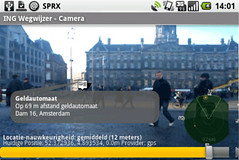 Augmented Reality without markers is powerful. Pull out your mobile phone and experience an augmented reality. It can be that simple. Only G1 (the Android - Google phone from T-mobile) owners had the opportunity to experience this with Wikitude from Mobilizy and later ING Wegwijzer. Its based on GPS data and the compass. Because the phone knows where it is (the GPS) and in what direction you are looking (the compass) it can augment reality on the screen correctly.
Augmented Reality without markers is powerful. Pull out your mobile phone and experience an augmented reality. It can be that simple. Only G1 (the Android - Google phone from T-mobile) owners had the opportunity to experience this with Wikitude from Mobilizy and later ING Wegwijzer. Its based on GPS data and the compass. Because the phone knows where it is (the GPS) and in what direction you are looking (the compass) it can augment reality on the screen correctly.
Level 2 - Markerless AR is halfway the technology trigger and will be nearing the peak of inflated expectations in a year when more phones have the combination of GPS and compass. The Nokia N97 which will be out in the summer will have a compass and will trigger the first non Android Markerless AR applications. It is unknown if the new iPhone will have this capability. It would be HUGH if it did…
Examples of GPS - Compass based AR:
- Mobilizy / Wikitude , video
- SPRXmobile / ING Wegwijzer
- Sixth Sense
- NRU /Last Minute
- Enkin (not heard from since the Android challenge, bought by Google according to rumours)
LEVEL 3 - Augmented Vision
This does not exist yet. As Rice says:
“We must break away from the monitor and display to lightweight transparent wearable displays (in an eyeglasses form factor). Once AR becomes AV, it is immersive. The whole experience immediately changes into something more relevant, contextual, and personal. This is radical and changes everything. As I have said before, this will be the next evolution in media. Print, Radio, Television, Internet, Augmented Reality (well, Vision). L3 must also be mobile massively multi-user, persistent, shared, dynamic, and ubiquitous.”
 It will be more then 3 years before anything remotely capable will be available. Until then we will have to make do with research news like that of the University of Washington where they are working on displaying pixels in contact lenses .
It will be more then 3 years before anything remotely capable will be available. Until then we will have to make do with research news like that of the University of Washington where they are working on displaying pixels in contact lenses .
In Conclusion
To me it’s daunting to see how far there is to go. Yet knowing where we are now, what is coming and how to frame it enables realistic planning and choices. I hope it helps you. I’ll be enjoying the ride and developing some cool AR initiatives with my SPRX partners.
Thanks to all AR bloggers and twitterers who directly and indirectly helped me put this together. Looking forward to see your feedback and more examples in the comments.
- April 2009
vrijdag 10 juli 2009
Augmented reality with social networks
Pretty amazing stuff as you can see on the video
Layar Wants More Layers, Opens Augmented Reality Platform To Developers
SPRXmobile
 , the startup behind Layar
, the startup behind Layar , the mobile augmented reality browser for Android, is moving fast. Barely three weeks after launching its application to much fanfare, it is opening up its platform by handing out keys for its just launched API to a select number of developers. (See my video interview with the company’s co-founder Raimo van der Klein
, the mobile augmented reality browser for Android, is moving fast. Barely three weeks after launching its application to much fanfare, it is opening up its platform by handing out keys for its just launched API to a select number of developers. (See my video interview with the company’s co-founder Raimo van der Klein for more context). Interested parties will need to fill out a request form, which should be available in about half an hour by following this link
for more context). Interested parties will need to fill out a request form, which should be available in about half an hour by following this link , and the company will subsequently handpick 50 developers and provide them with the necessary documentation, tools and a test environment for third-party layers.
, and the company will subsequently handpick 50 developers and provide them with the necessary documentation, tools and a test environment for third-party layers. Layar is far from the only player in the mobile AR browser market, which is shaping up to be an interesting field as devices and the operating systems they run see technological advances at an ever-increasing speed. Our friends over at Venturebeat recently published a great piece about AR browsers and listed Layar alongside similar tools like Tonchidot
and listed Layar alongside similar tools like Tonchidot ’s Sekai Camera
’s Sekai Camera and Mobilizy
and Mobilizy ’s WikiTude
’s WikiTude . Even IBM is playing around with mobile AR apps.
. Even IBM is playing around with mobile AR apps.
But ultimately, it will always come down to supporting as many platforms as soon as possible without neglecting the content part of the equation. Without a decent amount of usable layers, none of these AR browsers are going to see mainstream adoption any time soon, and Layar is the first to attempt luring third-party developers into creating layers on top of their system by means of an extensive API. In my opinion, it’s a logical step to take, and I’m curious to see if there will be enough developer interest.

woensdag 8 juli 2009
Asus will release three versions of the Asus Eee PC T91
An ASUS UK representative told AsusTablet.com that Asus will release three versions of the Asus Eee PC T91. We already knew about the T91GO which enables 3G, GPS and a digital TV features. In addition to the standard T91 (with a single-touch screen) and T91GO (or T91go), there will be the T91A. This model will be the only one to hold a multi-touch screen. It is not clear if this last version will or will not include the options of the T91go too or if there will be a fourth model (T91Ago), which includes both a multi-touch screen and 3G, GPS and a TV tuner.
An interesting point to note is that the T91A will weight about 0.06 kg more than the standard T91. This is because of the chips installed.
Here’s a line up of the specifications for the different models:
ASUS Eee PC T91A (Multi-touch)
“The Eee PC™ T91A measures just 225cm by 164cm, and weighs a mere 0.96kg—making it one of the smallest and thinnest gadgets with an 8.9″ display in the world today. The Eee PC™ T91A is the one of the first mini laptops to use a full multi-touch interface, supporting Microsoft Windows 7.”
- Screen: 8.9″ LED Backlight / Resistive Multi-Touch Panel
- Enabled for Microsoft Windows 7
- Resolution: 1024 x 600 (WSVGA)
- Battery: Li-polymer, 5.4 hours runtime
- Processor: Intel Atom Z520 - 1.33GHz
- OS: Windows 7
- Memory: 1Gb (DDR2); 2Gb Maximum
- Storage: SSD 16Gb + 16Gb SD Card (included)
- Online Storage: 20Gb (free for 18 mos.)
- Audio: HD / Stereo Speakers / Digital Array Mic
- Wireless: 802.11 b/g/n
- Bluetooth: Yes
- Camera: 0.3 Megapixel Built-in
- Color: Black / Silver
- Weight: 0.96 kg
ASUS Eee PC T91go (GPS, Digital TV and 3G enabled)
“The Eee PC™ T91Go measures just 225cm by 164cm, and weighs a mere 1.02kg—making it one of the smallest and thinnest gadgets with an 8.9″ display in the world today. The Eee PC™ T91go is a device for on the road. With its built-in Global Positioning System (GPS) and 3G connectivity, it supports advanced navigation capabilities on the go and enables you to connect to the web through a cellular connection. The DVB TV tuner makes watching television on your device a possibility for extensive entertainment options.”
- Screen: 8.9″ LED Backlight / Resistive Touch Panel
- Resolution: 1024 x 600 (WSVGA)
- Battery: Li-polymer, 5.4 hours runtime
- Processor: Intel Atom Z520 - 1.33GHz
- OS: Windows XP Home
- Memory: 1Gb (DDR2); 2Gb Maximum
- Storage: SSD 16Gb + 16Gb SD Card (included)
- Online Storage: 20Gb (free for 18 mos.)
- Audio: HD / Stereo Speakers / Digital Array Mic
- Wireless: 802.11 b/g/n
- Bluetooth: Yes
- Camera: 0.3 Megapixel Built-in
- Color: Black / Silver
- Weight: 1.02 kg
- GPS: Yes
- 3G Module: Yes
- Digital TV Tuner: Yes
ASUS Eee PC T91 (Standard)
“The Eee PC™ T91 measures just 225cm by 164cm, and weighs a mere 0.96kg—making it one of the smallest and thinnest gadgets with an 8.9″ display in the world today.The Eee PC™ T91’s tablet PC functionality makes it easy to cradle in one arm, enabling users to read documents, scribble ideas into digital notebooks and surf the Internet while traveling on foot. ”
- Screen: 8.9″ LED Backlight / Resistive Touch Panel
- Resolution: 1024 x 600 (WSVGA)
- Battery: Li-polymer, 5.4 hours runtime
- Processor: Intel Atom Z520 - 1.33GHz
- OS: Windows XP Home
- Memory: 1Gb (DDR2); 2Gb Maximum
- Storage: SSD 16Gb + 16Gb SD Card (included)
- Online Storage: 20Gb (free for 18 mos.)
- Audio: HD / Stereo Speakers / Digital Array Mic
- Wireless: 802.11 b/g/n
- Bluetooth: Yes
- Camera: 0.3 Megapixel Built-in
- Color: Black / Silver
- Weight: 0.96 kg
maandag 6 juli 2009
Eurotech Announces Two New Panel PC and Box Computer Models

| NewswireToday - /newswire/ - Amaro, Udine, Italy, 07/03/2009 - Eurotech announces the new Panel Computer Vx-120F-N270 and Vx-150F-N270, based on the Intel® Atom™ N270 series, and the new Bx-400F-N270, an extremely rugged and compact box computer. | |||
| Eurotech announces today the new Panel Computer Vx-120F-N270 and Vx-150F-N270, based on the Intel® Atom™ N270 series. The efficiency, high performance and low power consumption of the 1.6GHz Ultra Low Voltage processor are embedded in a highly integrated design making them totally compatible with Intel® Core™ platforms. These two new models join Eurotechs comprehensive range of Vx Panel PCs. | |||
donderdag 2 juli 2009
Cisco to Expand Mobile Collaboration Features
Cisco will tackle the mobile world over the next year with a series of new features to bring smartphones into business communications, the head of the company's software group said at the Cisco Live conference on Wednesday.
As Cisco creates sophisticated interfaces for collaboration using text, voice, video and other media, mobile phones have been largely left out despite the fact that they are nearly ubiquitous. For one thing, IT departments often have an arm's-length relationship to cell phones. In most IT departments, they represent the largest uncontrolled expense, said Don Proctor, senior vice president of Cisco's software group, in a session at the conference in San Francisco.
Proctor and Chris Chamberlain, a director of product management in Cisco's Unified Computing group, discussed a set of future capabilities for better enterprise collaboration on smartphones. Cisco intends to deliver them by the second half of next year, Chamberlain said. The upcoming features included the following:
- If an employee is talking on a smartphone, Cisco's software can indicate that in the employee's presence information. Coming up, if a colleague sends an instant message to that person, it can be converted to an SMS that can be retrieved on the cell phone without dropping the call.
- A speech-to-text engine will be able to convert a voicemail to text so that a user participating on a WebEx conference can read it without interrupting the conference. The user could then go into a text-based conversation with the sender of the voicemail and also bring that person into the WebEx conference.
- If a piece of content such as a chart came to the smartphone through an RSS feed, the smartphone user could view the chart on the phone and then bring it into the document-sharing portion of an ongoing WebEx conference.
- If a smartphone user in a WebEx conference loses network coverage in a location such as a tunnel, the conference call will remain "anchored" so it can be reconnected after the user regains coverage. That will save the trouble of re-entering sign-on information.
- When employees with smartphones go to a remote office of the organization, they can view a map of the office and view their location in it, detected via Wi-Fi. That map would show available meeting rooms where the employees could start working.
- Once in the meeting room, the remote employee could be notified of resources in the room such as an IP desk phone and video screen and then use those to continue the meeting, controlling the whole process via the smartphone. If the person needed to leave the room, he or she could disconnect from the desk phone and screen but remain in the conference, continuing it outside on the smartphone.
Cisco intends to make these capabilities available on a variety of smartphone platforms. The company introduced an iPhone client for WebEx earlier this year. Cisco intends to use the native interface of each type of phone as much as possible to create a natural and easy user experience, Proctor said.
woensdag 1 juli 2009
Augumented reality again - where are we now
Many of the links in this article are for video demos. Rather than having a string of 30+ videos cluttering and breaking up the article, I’ve chosen to set up a separate video page. When you click a video link, it will open a second window. You can view the related video as well as navigate all of the other videos from this window. If your monitor is large enough to permit, I would even suggest leaving the second window open for the videos to cue each video when needed, as you read through the article. To differentiate the video links from other links, links to videos are each followed by a “¤”. To open the window now, click here ¤.

While social media in general, and Facebook and Twitter specifically, have been monopolizing mainstream media’s coverage of online trends, augmented reality is getting a lot of inside-the-industry exposure, mostly for its undeniable wow factor. But that wow factor is a double edged sword, and advertising has a way of turning trends into fads, just before they move on to the next brand new thing. So for this article I wish to focus on practical applications and augmented reality with clear end user benefits. I’ve deliberately chosen not to address entertainment and gaming related executions as it is beyond the scope of this article and frankly merits dedicated attention all its own. And perhaps I’ll do just that in a future article.
Can it Save the Car?
The automotive industry was an early adopter. Due to the manufacturing process, the CAD models already exist and the technology is very well adaptive to showing off an automobile from a god’s eye view. Mini ¤ may have been first off the pole position, with Toyota ¤, Nissan ¤ and BMW ¤ tailgating close behind. Some implementation of AR will soon replace (or augment) the “car customizer” feature that is in some form standard on all automobile websites.
The kind of augmentation that is so applicable to automotive is also readily adaptable to many other forms of retail. Lego ¤ is experimenting with in store kiosks that feature the assembled kit when the respective box is held before the camera. Because legos are a “kit” the technology is very applicable in-store, however I find the eCommerce opportunities much more compelling. Ray-Ban ¤ has developed a “virtual mirror” that lets you try on virtual sunglasses from their website. Holition ¤ is marketing a similar implementation for jewelry and watches. HairArt is a virtual hairstyle simulator developed for FHI Heat ¤, maker of hair-care products and hairstyling tools. While demonstrating potential, some attempts are less successful ¤ than others (edit: I just learned of a better execution of an AR Dressing Room by Fraunhofer Institut). One of the most practical, useful implementations I’ve seen is for the US Post Office ¤— A flat rate shipping box simulator (best seen). These kind of demonstration and customization applications will soon be pervasive in the eCommerce space and in retail environments. TOK&STOK ¤, a major Brazilian furniture retailer, is using in-store kiosks to view furniture arrangements, though I personally find theirs to be a poor implementation. A better method would be to use the same symbol tags to place the AR objects right into your home, from the camera connected to your PC. And that’s just what one student creative team has proposed as an IKEA ¤ entry for their Future Lions submission at this years Cannes Lions Advertising Festival. A quite sophisticated version of this same concept has also been developed by Seac02 ¤ of Italy.
To Tag, or not to Tag?
A couple of years ago I wrote here about QR codes. A couple of weeks ago, while attending the Creativity and Technology Expo, I was given a private demo of Nokia’s Point & Find ¤. This is basically the same technology as QR codes, but uses a more advanced image recognition that doesn’t require the code. Candidly I wasn’t terribly impressed. The interface is poor and the implementation is so focused on selling to advertisers that they seemed oblivious to how people will actually want to use it, straightjacketing what could be a cool technology. Hopefully future versions will improve. Most implementations of augmented reality rely on one of two techniques— either a high degree of place-awareness, or some form of object recognition. Symbols similar to QR codes are most often used when the device is not place-aware, though some like Nokia’s Point & Find don’t require a symbol tag. Personally, even if the technology no longer requires it, I feel the symbol or tag-code is a better implementation when used for marketing. We are still far from a point where everything is tagged, so people won’t know to inspect if a tag-code is not present. Furthermore, the codes place around on posters and printed material help build awareness for the technology itself. Everything covered here thus far has been recognition based augmented reality.
Through the Looking Glass
Location-aware augmented reality usually refers to some form of navigational tool. This is particularly noteworthy with new applications coming to market for smartphones. As BlackBerry hits back at the iPhone, Android’s list of licensees grows and the Palm brings a genuine contender back to the table with the new Palm Pre, there is huge momentum in the smartphone market that not even the recession can slow down. I personally think the name “smartphone” is misleading as these devices are far beyond being a mere ‘phone’. Even a very smart one. They are full-on computers that, among many other features, happen to include a phone. In my prior article on augmented reality I focused on the iPhone’s addition of a magnetometer (digital compass). This gave the iPhone the final piece of spacial self-awareness needed to develop AR applications like those coming fast and furious to the Android platform. Think of it like this— The GPS makes the phone aware of its own longitudinal and latitudinal coordinates on the earth, the compass tells it which direction it is facing, and the accelerometer (digital level-meter) determines the phone’s degree from perpendicular to the ground (this is what lets the phone’s browser know whether to be in portrait or landscape mode). Through this combination of measures the device can determine precisely where in the world it is looking. There is already a fierce race to market in this highly competitive space. Applications like Mobilizy’s Wikitude ¤ (Android), Layar ¤ (Android) and other proof of concepts seeking funding like Enkin ¤ (Android) and SekaiCamera ¤ (iPhone) are jockeying for the mindshare of early adopters. Others have developed proprietary AR navigational apps such as IBM’s Seer ¤ (Android) for the 2009 Wimbledon games. Two months ago when Nine Inch Nails released their NIN Access ¤ iPhone app, there was no iPhone on the market with a built-in compass, so the capability for this level of augmentation was not yet available, but a look at the application’s “nearby” feature gives a hint at the kind of utility and community that could be built around a band or a brand using this kind of AR. View a demo of Loopt ¤, and only a little imagination is needed to see how social networking can be enhanced by place awareness, now add person-specific augmentation tied to a profile and the creepy stalker potential is brought to full fruition, depending on your perspective. And there are other well established players in the automotive navigation space that have a high potential for crossover. The addition of a compass to the iPhone paved the way for an app version of TomTom ¤. Not to be outdone, a Navigon ¤ press release has announced that they too have an iPhone app in development. How long before location-aware automotive navigation developers choose to enter the pedestrian navigation space?
Some Assembly Required
It seems everyone wants some AR business from IKEA. Another spec project by a student at the University of Singapore proposes an assembly instruction manual for IKEA ¤ furniture. In a more sophisticated application on the same line of thought, BMW ¤ is experimenting with augmented reality automotive maintenance and repair technology. Note in that video that he is not doing this in front of his laptop camera, nor is he holding his smartphone in front of his face. He’s wearing special AR eyewear. The potential for hands-free instruction and tutorial is as obvious as it is unlimited. Consider any product you purchase that comes with instructions (You do read the instructions, right?). A municipal construction crew repairing a broken water pipe could effectively have X-Ray vision, seeing where all the pipes are under the road, based on schematics supplied to their eyewear from city records.
Seeing is Believing
When it comes to Virtual Reality, I’ve had a mantra that none of this will really take off until we’re in there versus looking at there. I believe augmented reality will be the catalyst that pushes digital eyewear into the marketplace. Virtual World applications are, by their nature, not location dependent. In many ways that’s the point— you can be anywhere. And sitting at your computer or game console and looking at a screen is a well established all-purpose interface. Place-aware augmented reality, on the other hand, is location dependent— Walking down the street holding your smartphone in front of your face is not a long-term solution. In only a short couple of years, a bluetooth earpiece ¤ has gone from being the goofy guy walking down the street who looks like he’s talking to himself, to a common everyday accessory, even fashionable. What works for your ears is now coming to your eyes— a hands-free visual interface in the form of eyewear. Some variation of this concept has been around for a long time ¤. Slow to improve, even most contemporary models are less fashionable than a Geordi LaForge’s visor, but slowly they are improving.
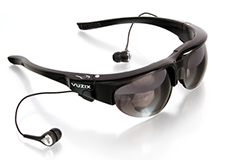 The Vuzix Wrap 920AV (at left), prototype premiered at the 2009 CES in Las Vegas, are the newest consumer class digital eyewear marketed for augmented reality applications. WIRED Magazine’s Gadget Lab feels their most significant feature, “comes from the fact that the company finally hired a designer aware of current aesthetic tastes.” Significant to the 920AV’s is that: A. They boast ‘see-thru’ video lens that readily lend themselves to augmented reality applications, and B. They are stereoscopic (meaning they have a district video channel for each eye, required for 3D). They are meant to hit the market in the Fall, and are being pushed as an iPhone compatible device. If they are smart, they will do a bundled play with a “killer app” such as SekaiCamera or similar product. They have the potential to be the ‘must have’ gift for the 2009 holiday season. Not to oversell them, I have not personally demoed them yet so I don’t know if they will deliver on the hype, but they look as though they will be first to market, and their product will be the leading contender in the immediate future. Here is a demonstration of a prior Vuzix model ¤ (behold the fashion statement). Using symbol-tag based augmented reality, this man places a yacht in his living room.
The Vuzix Wrap 920AV (at left), prototype premiered at the 2009 CES in Las Vegas, are the newest consumer class digital eyewear marketed for augmented reality applications. WIRED Magazine’s Gadget Lab feels their most significant feature, “comes from the fact that the company finally hired a designer aware of current aesthetic tastes.” Significant to the 920AV’s is that: A. They boast ‘see-thru’ video lens that readily lend themselves to augmented reality applications, and B. They are stereoscopic (meaning they have a district video channel for each eye, required for 3D). They are meant to hit the market in the Fall, and are being pushed as an iPhone compatible device. If they are smart, they will do a bundled play with a “killer app” such as SekaiCamera or similar product. They have the potential to be the ‘must have’ gift for the 2009 holiday season. Not to oversell them, I have not personally demoed them yet so I don’t know if they will deliver on the hype, but they look as though they will be first to market, and their product will be the leading contender in the immediate future. Here is a demonstration of a prior Vuzix model ¤ (behold the fashion statement). Using symbol-tag based augmented reality, this man places a yacht in his living room.
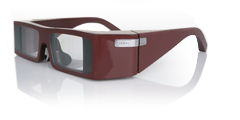 If the quality of the user experience fails to live up to expectations, Vuzix has many pretenders to the crown. Fast followers like Lumus (at left) and others are trying to get products to market as well. Then there are MyVu, Carl Zeiss, i-O Display Systems and others who have video eyewear products and are likely candidates to come forward with AR offerings. Add to that a technical patent awarded to Apple last year for an AR eyewear solution of their own and it is clear this could quickly become a crowded and competitive product category. This video titled Future of Education ¤, while speculative, is a splendidly produced and rather accurate projection of where the technology is going.
If the quality of the user experience fails to live up to expectations, Vuzix has many pretenders to the crown. Fast followers like Lumus (at left) and others are trying to get products to market as well. Then there are MyVu, Carl Zeiss, i-O Display Systems and others who have video eyewear products and are likely candidates to come forward with AR offerings. Add to that a technical patent awarded to Apple last year for an AR eyewear solution of their own and it is clear this could quickly become a crowded and competitive product category. This video titled Future of Education ¤, while speculative, is a splendidly produced and rather accurate projection of where the technology is going.
Where to From Here?
We’re moving in this direction at exponential speed, the pace of progress is only going to keep moving faster. As we see the convergence of augmented reality with mobile and mobile with ear and eyewear, there are another set of convergences just over the horizon. We’re on the threshold of realtime language translation ¤. This is an ingredient technology and, like a spell-checker, will soon be baked in to all communications devices, first of which will be our phones. The Nintendo Wii brought motion capture into our homes, and technologies like Microsoft’s Project Natal ¤ are converging motion capture with three dimensional optical recognition, so no device is needed. And everything, both real and virtual, will soon be integrated into the semantic web. Intelligent agents will assist us with many tasks. While most of this intelligence will occur behind the curtain, as humans we like to personify our technology. It won’t be long before our personal digital assistant could be given the human touch. How human?








